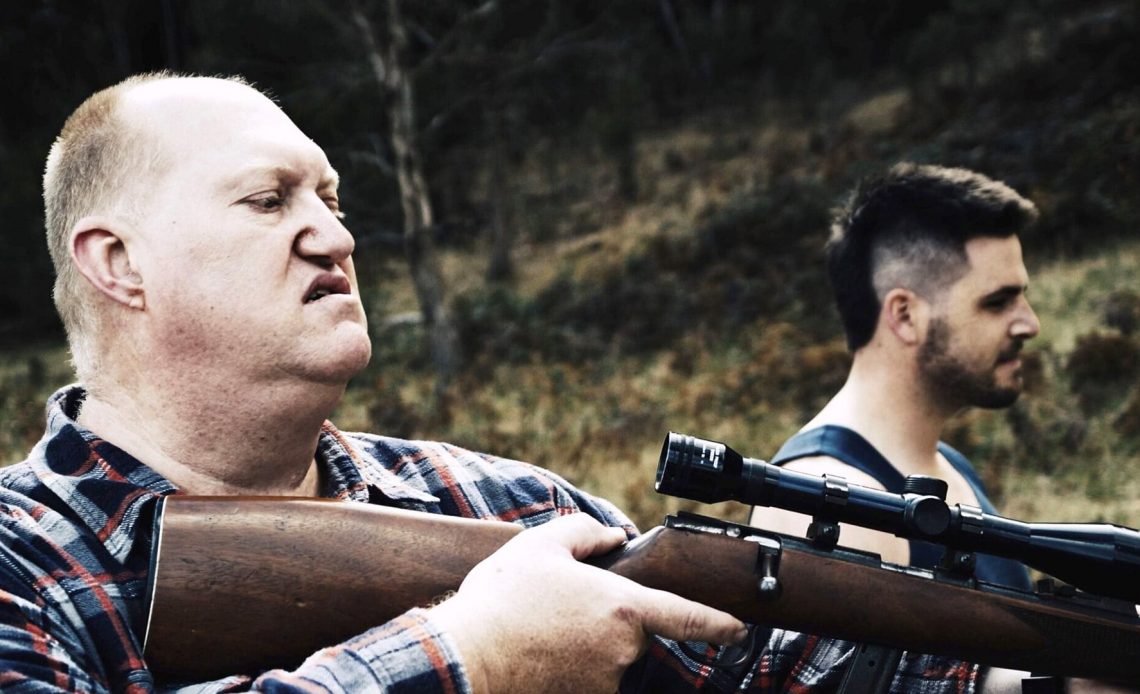Writer/Director Sam Curtain pulls no punches in the unsettling, terrifying and intense horror feature, The Slaughterhouse Killer.
The film opens with a grim view of Box (Craig Ingham) sleeping on a putrid mattress, surrounded by a disgusting mess, with obligatory Aussie blowflies; there’s an otherworldly sense to the intro that makes your skin crawl. We follow him on an average day, doing average mundane things; buying meds at a pharmacy, listening to right-wing talkback radio, stalking his prey. It’s just another day in the life of Box.
Ingham fills the shot in every scene he’s in; he’s massive and creepy. Everything about his performance screams menace, from stalking his prey to terrorising his victims before the kill to strangling someone with his bare hands—even while spewing right-wing views, ranting about his hatred of the world. Early on, he meets Nathan (James Mason), out on parole and looking to make a fresh start in a new job. However, things start going awry when a couple of co-workers begin bullying the new guy, taking things too far, and Box shows Nathan that he has a knack for killing.
Everything about The Slaughterhouse Killer is bleak and grimy. The colour palette gives you a sense of a true-crime re-enactment, which keeps the tension, and the momentum tight. Utilising real locations such as an actual slaughterhouse, pub, and houses gives the narrative the authenticity you don’t often find in many overly sleek, big-budget horror films. There’s a sense of foreboding in this town; it has the feel of a dead-end—everyone seems to be stuck here. Claustrophobia and the feeling of eternal dread in the film harken back to Ozploitation films of the 1970s and 80s, films like Wake in Fright (1971), The Cars That Ate Paris (1974) and Inn of the Damned (1975). The Slaughterhouse Killer has all the hallmarks of classic Ozploitation cinema.
The uneasiness and the creepiness you feel keeps rising as the film goes on; once the thinly veiled mask is pulled back, we get to see what Box and Nathan are truly capable of. James Mason works well as Nathan; he’s sympathetic and relatable, a tortured soul who gets so swept up in the mayhem and the murder that he doesn’t realise what he’s doing until it’s far too late. The more Nathan is led down Box’s rabbit hole, the stronger the hold Box has on him. The longer their partnership continues, the darker the desires become.
These darker desires are heightened by Box’s lust for Nathan’s girlfriend, Tracey (Kristen Condon). Tracey acts as the heart of this movie; she’s moved to this small town to reconnect with Nathan and wants to make a go of it, trying to find work so they can have a moderately normal life. Condon’s performance is controlled, believable, and ultimately tragic. All three leads have genuine chemistry with each other. The short moments of levity the director allows his characters, even though they create a slight tonal shift, are rewarding. It develops the characters and shows a bit of light that this film needs in the middle, delivering it seamlessly.
We know these characters—we’ve met them before, if not in the cinema, at least in real life. That’s ultimately this film’s greatest strength; this is not a supernatural slasher where the killer can survive being thrown from a roof, incinerated or shot a dozen times in the chest and keep chasing after his victims. It’s grounded in reality—which makes it all the more terrifying. We know from our recent history in Australia that men like Box exist. There are even references to Port Arthur that gives The Slaughterhouse Killer a frightening realism that you don’t see coming, but once it’s there, it remains.
Sam Curtain directs from a script he co-wrote with Benjamin Clarke, which helps the narrative’s authenticity. Arabella Barwick’s gore make-up is at times quite grotesque and thoroughly enjoyable. Composer Caleb Jacobs’ score is haunting and adds another layer of other-worldliness and creepiness that draws you in from the start. The camera work and editing are tight, and no shot is wasted in The Slaughterhouse Killer. Every frame and every minute on the screen propels the story forward. That tightness is to be applauded; there is no drag for a relatively short-running film, no padding.
This is not Wolf Creek (2005) or another Saw (2004) wannabe. The Slaughterhouse Killer is a well-crafted work that doesn’t get aroused by its gore and ripped-out flesh as many horror/slasher films do. We don’t see every kill but instead see reactions from characters in the middle of a hideous murder, which can have more impact, rather than showing the kill in all of its vile and bloody detail. This film is not trying to start a franchise—this is horror as it should be; brooding, bleak, dark, engrossing, and most of all, unsettling.
Though the title sounds B-grade, The Slaughterhouse Killer is an independent horror film and an Australian film that people need to see. It may not be everyone’s cup of tea, but it’s murky, intense, pulls no punches and leaves you with a really bad taste in your mouth, as all good horror movies should. It may even make you think about adopting a vegan diet.
Fun Fact:
Craig Ingham was nominated for Best Actor at the Australian Screen Industry Network awards.




COMMENTS